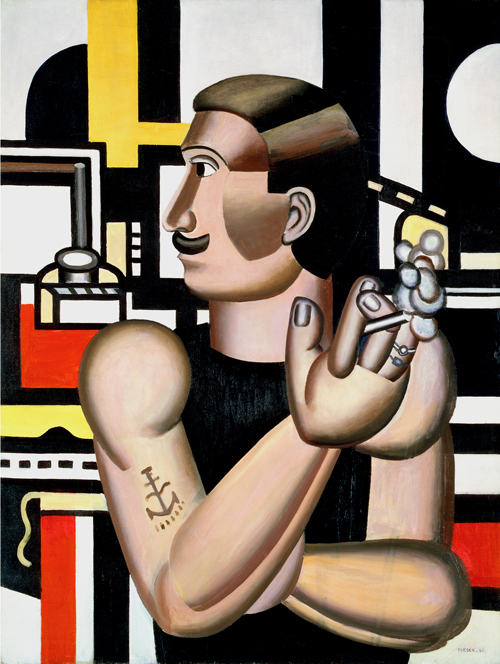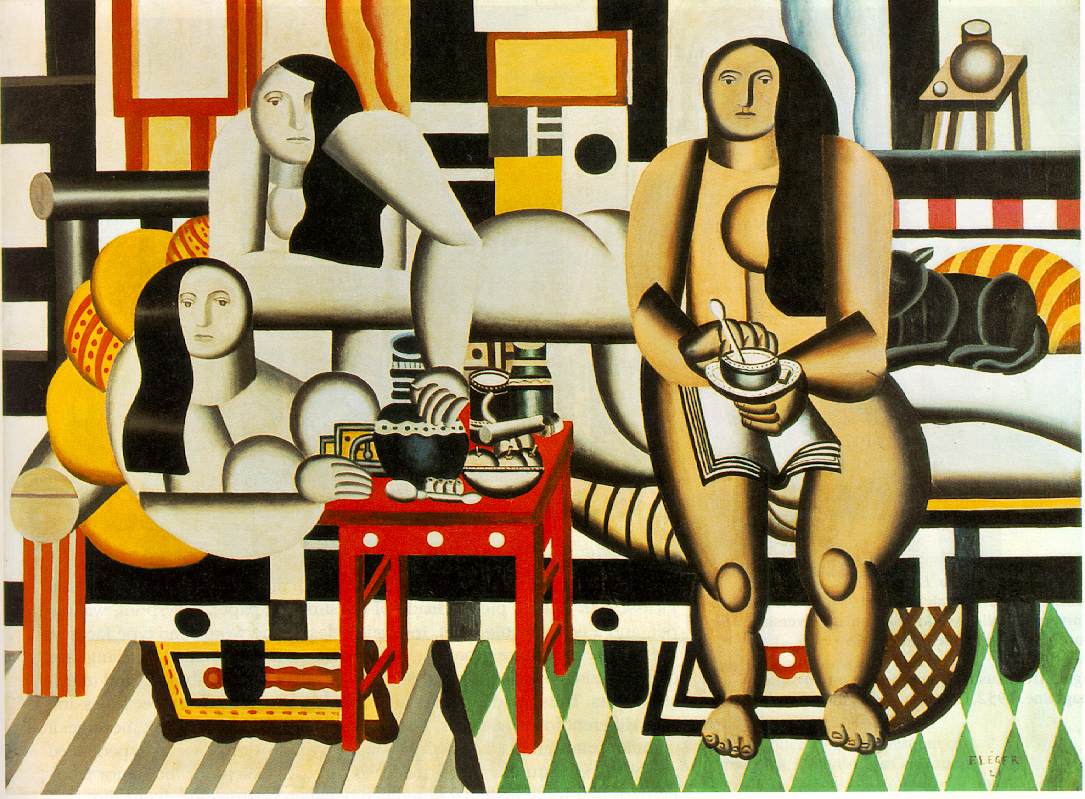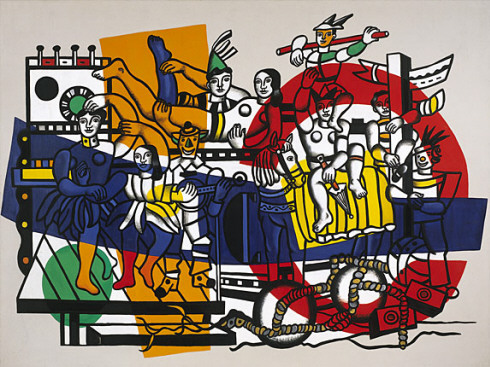MACHINERY OF POETIC ART
Every so often there surfaces in art an image that is so compelling, so absolutely true to one particular moment in history, that it puts the historians out of business. One such image is evoked by ”The Mechanic”, Fernand Leger’s painting of 1920 that fixes once and for all the idea that the life of the industrialized masses need not be without dignity, nor the individual mass-person turned into a disinherited cipher.

Fernand Leger. The Mechanic. The Mechanic seemed in 1920 to signal a new and happier industrial age.
Leger ( 1881-1955)was a master of plain statement and also a man whom doubt and compromise and equivocation seemed abhorrent. He believed that the conveyor belt and the assembly line had changed life for the better, and that the industrialized working man would have his full share of the benefits of his hard work. It was a matter of faith with him that the mechanic was the New Man, the man for whom the machine was not a tyrant but the instrument of social liberation.
This could have led to a Stalin type propaganda image of the heroic worker, but Leger’s mechanic is not at all like that,despite his bulging muscles. He is a man with a mind of his own. No faceless and generic abstraction, he is distinctively a Frenchman of the 1920′s with his nautical tatoo, his sleeked down hair and heavy mustache, his cigarette at the ready and rings on his well fleshed finger.
But there is also something very grand and timeless about him. Leger gave his mechanic a look of ancient art in the severe frontal pose of the torso and the right angled turn of the head on the neck . The mechanic meets us both head on and in profile, as he might in an Assyrian relief Behind him, in terms of geometric flat planes and brilliant color, is the ideal place of work; the factory that never was. Looking at the casquelike cut of the forehead and cheekbones, we see immediately that this man is at one with his machines and could wish for no greater fulfillment than to be in charge of them.
Not surprisingly, Leger himself was not of industrial origins, and he never in his life worked in a factory. He was the son of a cattle breeder in Normandy and if his father had not died suddenly when Leger was in school, there would never have been any question of his son being allowed to stray from the family business.
Leger was of an accepting nature. He took change for granted, and welcomed it. That a new world should produce a new kind of art seemed to him not merely natural but axiomatic. Old style aesthetes might wince to see red and yellow billboards set up among the halftones of the French countryside; Leger thought it was the best thing that could happen. In 1914 he said,”modern man has to take in a hundred times more impressions as came his way in the eighteenth century. Is it surprising that our language is full of diminutives and abbreviations? If modern paintings are highly condensed, amd if the forms with them are taken apart and redistributed, it’s for the same reason”
To Leger, color was fundamental to modern life.The negative reaction to street posters and lit advertising by the middle class, was a dynamic that Leger felt would not survive a new industrialized world of color that featured strong contrasts. Machinery had new color too. Leger went to a pioneer aviation show in paris with Marcel Duchamp; as they walked among the prehistoric aircraft, with their exposed machinery and huge wooden propellors, Duchamp grew more and more silent. Suddenly he blurted: Painting’s finished. How can we possibly compete with those propellors?” , Leger would say as he told the story, ”but then I always preferred metal to wood.”
Leger had been on the very edge, in 1912-1913 of a purely abstract art. An art based on contrasted forms that had no reference to the visible world. No sooner was he in the army than activity of that kind began to seem to him both petty and futile. ”What faces they had! What a shrewd lively, and completely down to earth understanding of everything that went on! They were true poets in their everyday speech, so vivid and so inventive in their slang. And then the sight of the open breech of a 75mm cannon! The magic of the light on that white metal! One taste of all that, and I forgot about abstract art.”
Leger, was however, very careful at the start not to sentimentalize the working man, or to assign to him a more important place in the cities of the future than he would actually occupy. In the great metropolitan paintings that Leger produced in the 1919-1920 period such as ”The City”,human beings play a subordinate role. They are objects among objects and are not individualized. Individuality was kept for moments when as in the ”Mechanic” , the working man was off duty and could smoke a cigarette. Rather, it raised him to the same level, in Leger’s estimation, as that of a functional elegance, a stripped down beauty without precedent, that was the mark of every other element in the new metropolitan scene.
However, not everyone looked with favor on the first machine age. In 1932, Rene Clair’s ”A Nous La Liberte” was popular for its portrait of the dehumanizing effect of industrialization. Chaplin’s modern times of 1936, was a further and definitive example of this same disenchantment. But Leger did not stand alone in his optimistic approach to the postwar world. In the social strivings of the 1920′s the machine had a fundamental, and it was hoped, a benevolent part to play.Leger had an expansionist and utopian dream which was the notion of a world in which art would be for everyone and everyone would be for art.
The automobile shows of the mid 1920′s would have emptied the museums and bankrupted the theaters, in Leger,s view if it were not for what he called ”the hierarchical prejudice”. ”There are no hierarchies in art,” he said over and over again; it was for the skilled craftsman to realize that what he produced was more beautiful than most of what people went to see in the Louvre.
The role of color in all this was primordial, and Leger never lost an opportunity of listing the benefits that would follow from the liberation of color in everyday life. ” In 1919, I painted ”The City” with pure colors laid flat on the canvas. It was a revolutionary step. I proved that a painter could discard chiaroscuro and discard modulation and still have depth in the picture. The advertising agencies soon took my point. My pure blues, reds and yellows were lifted from ‘The City’ and put to work in posters and store windows…Color had been set free. It was a reality in itself. It could act in itself and by itself, independently of all the objects which had previously had to contain or carry it.”
There is a great difference between a painting that corresponds to an urgent social need, to something that has to be said, and one that does not. His later paintings related to a France that had passed into history. The communist party to which he belonged, was deeply conservative, dependent on the status quo, and the optimistic dream of Marxian social theory, his friendship with Leon Trotsky,werepart of a sentimental past no longer relevant to the nuclear age.The radical invention of the earlier period had muted into descriptive and particularly simplistic views of the working classes that were no longer valid.
The machine had not, after all, turned out to be the instrument of social liberation; and in just about every country the hard-hat had become the henchman of reaction.The rhetorical sweep of the left was as empty as the establishment. Neither at work nor at play did the construction worker of the 1950′s match up to the New Man Leger had put on canvas thirty years earlier. That specific impulse, and that specific art, had its moment of validity in the 1920′s. Art was the poorer for its disappearance; reinvention was impossible since the archetypes were in perpetual movement. Technology and science were liberating and enslaving across class lines.



